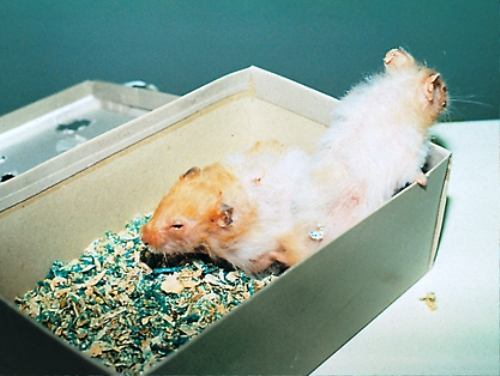Difference between revisions of "Small Mammals Q&A 16"
| Line 29: | Line 29: | ||
|q4= What recommendations would you make to the owner? | |q4= What recommendations would you make to the owner? | ||
|a4= Completely clean the cage and use non-toxic pelleted bedding. When handling, wear gloves or wash hands with a germicidal hand soap afterwards. | |a4= Completely clean the cage and use non-toxic pelleted bedding. When handling, wear gloves or wash hands with a germicidal hand soap afterwards. | ||
| − | |l4=Demodicosis | + | |l4=Mites - Hamsters#Demodicosis |
</FlashCard> | </FlashCard> | ||
Revision as of 15:41, 16 July 2011
| This question was provided by Manson Publishing as part of the OVAL Project. See more |
These two adult pet hamsters have developed chronic, non-pruritic generalized alopecia with scaling and crusts most evident around the ears and feet. A child in the household plays with the hamsters and was recently treated for dermatophytosis.
| Question | Answer | Article | |
| What are your differential diagnoses for the hamster’s skin changes? | They include demodectic mange (Demodex aurati, D. criceti), dermatophytosis, low protein (under 16%) feed, bedding abrasion, systemic disorders associated with ageing, including renal amyloidosis and renal neoplasia, staphylococcal pyoderma, adrenocortical neoplasia and other endocrine disease.
|
Link to Article | |
| What diagnostic tests would you perform? | Examine a deep skin scraping microscopically.
Prepare a mineral oil or KOH wetmount to assess for fungal hyphae. Culture the skin and hair for fungal and bacterial pathogens and evaluate the diet and husbandry practices. Perform further diagnostic tests as needed including radiography, ultrasonography, hematology, urinalysis and a serum biochemistry panel. A heavy infestation of Demodex spp. was identified in this case. Additionally, abundant growth of Trichophyton mentagrophytes on dermatophyte test medium was observed. |
Link to Article | |
| How would you treat the hamsters? | Attempt to treat demodectic mange with ivermectin. Repeat the ivermectin twice at 10–14 day intervals. This treatment often does not work because ivermectin may not be effective. Use of amitraz is dangerous in hamsters because even when diluted it is extremely toxic to this species. Usually Demodex spp. become clinically apparent when there is underlying primary disease such as adrenal gland disease, neoplasia, severe environmental stress, malnutrition and other systemic disease.
Demodicosis is not zoonotic. T. mentagraphytes or Microsporum canis are the most common causes of dermatophyte infections in hamsters. Dermatophyte infections on hamsters can be zoonotic. Treat dermatophytosis with griseofulvin. Treat localized infections with a topical antifungal cream or lotion. |
Link to Article | |
| What recommendations would you make to the owner? | Completely clean the cage and use non-toxic pelleted bedding. When handling, wear gloves or wash hands with a germicidal hand soap afterwards.
|
Link to Article | |
